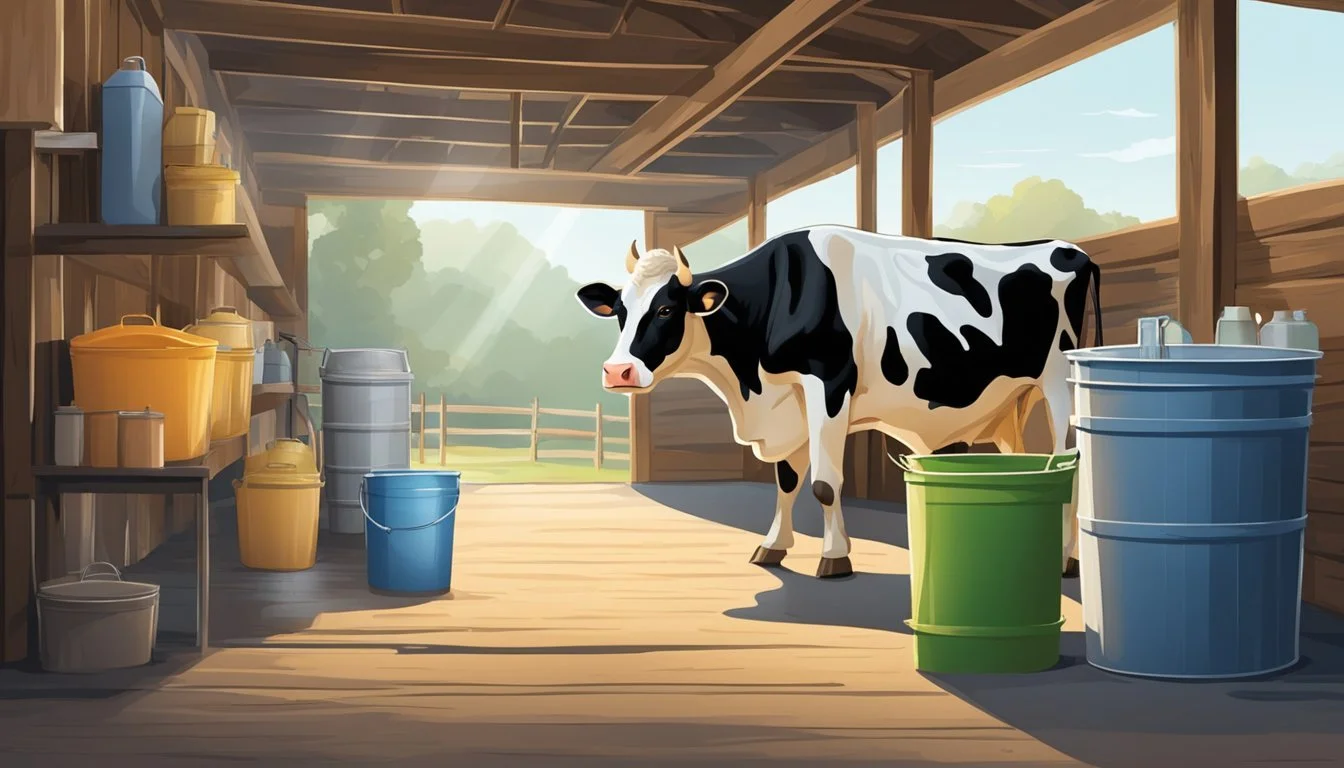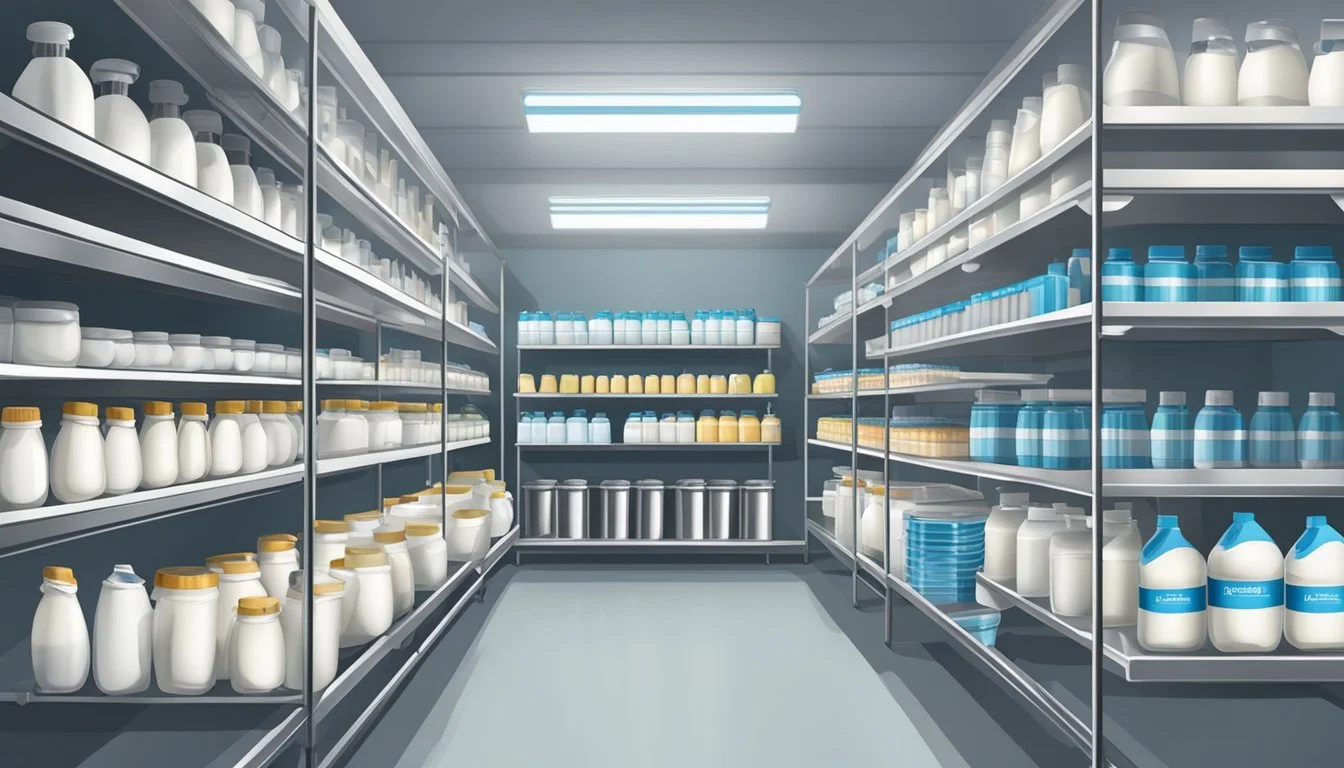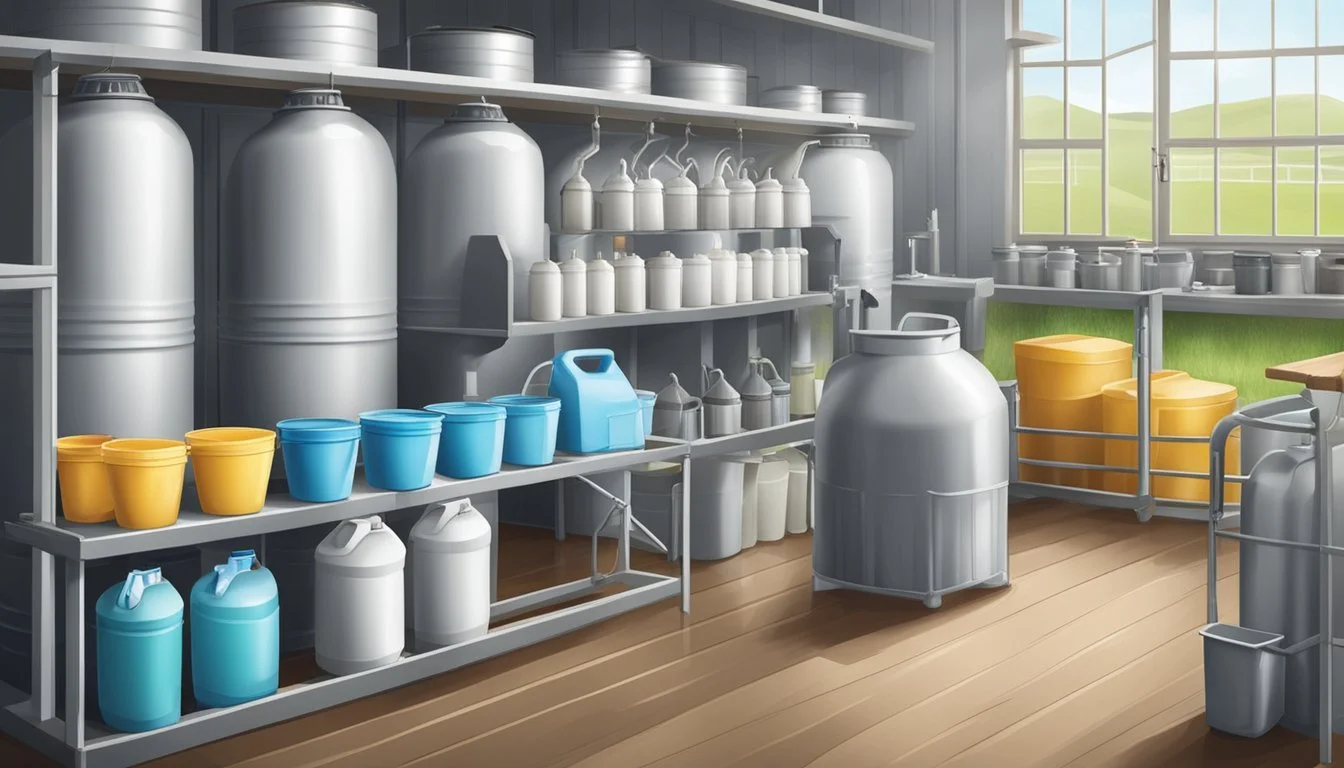Essential Milking Supplies for Dairy Animals
A Guide to Pails, Sanitizers, and Key Equipment
Milking dairy animals efficiently and safely is a cornerstone of successful dairy farming, necessitating a range of specialized supplies. These essentials not only streamline the process but also ensure the quality and hygiene of the milk produced. Dairy supplies such as milking pails are fundamental for the collection of milk, with materials like stainless steel being preferred for their durability and ease of cleaning.
Sanitation is a critical component in dairy operations. Every piece of equipment that comes into contact with milk or the animals must be adequately cleaned and sanitized to prevent contamination and spoilage. This involves using specific cleaning agents and sanitizers that are effective in removing milk residues and killing harmful microorganisms. Maintaining proper refrigeration is also crucial, as it preserves the freshness of the milk and prevents bacterial growth, with temperatures below 45 degrees Fahrenheit considered ideal.
For dairy farmers, investing in the right supplies goes beyond mere necessity; it is a commitment to maintaining the highest standards of dairy production. Quality milking supplies coupled with strict sanitation protocols are the backbone of dairy farm management, ensuring that the milk that reaches consumers is as fresh, clean, and wholesome as it should be.
Understanding the Basics of Milking
The success of a dairy operation relies heavily on a proper understanding of dairy animal anatomy, the lactation and milking cycles, and the fundamentals of udder health to ensure high-quality milk production and animal welfare.
Anatomy of Dairy Animals
Dairy animals, including cows, goats, and sheep, have udders that are integral to milk production. The udder is a complex organ consisting of milk-producing glands, known as alveoli, and ducts that lead to the teat canal where milk is released. An understanding of this anatomy is crucial for effective and safe milking practices.
Lactation and Milking Cycles
Lactation is the period when a dairy animal produces milk, initiated by the hormones following birthing. Milking routines must align with each animal's lactation cycle for optimal milk yield. Routinely milking at consistent times helps maintain milk production levels and supports the animal's comfort.
Lactation Phases: Beginning with colostrum production post-calving and transitioning to mature milk.
Milking Frequency: Varies by species; cows are typically milked two or three times daily, while goats and sheep may require less frequent milking.
Fundamentals of Udder Health
Maintaining udder health is paramount to prevent infections like mastitis, an inflammation of the udder tissue. Udder health practices include:
Regular Inspection: For signs of swelling, heat, or redness.
Hygiene: Thorough cleaning of the udder and teats pre- and post-milking.
Gentle Handling: To avoid injury and stress during milking.
Udder Balm: Application after milking can aid in keeping the skin healthy and supple.
Keeping these basics in check ensures the wellbeing of dairy animals and the quality of milk they produce.
Milking Equipment Essentials
In the world of dairy farming, efficiency and hygiene are paramount. The following subsections detail the essential milking equipment required to maintain a high standard of milk production.
Milking Machines and Their Components
A milking machine enhances productivity and ensures consistency in milk extraction. The core components include:
Vacuum Pump: It creates suction to extract milk.
Teat Cups: These connect to the animal's teats and the vacuum system.
Liners: Placed inside teat cups, they act as an interface between the teats and the equipment.
Milk Bucket or Stainless Steel Pail: These containers collect milk from the teat cups.
Milk Filters: Essential for purifying the milk of contaminants.
Efficient milking machines often integrate seamless operation of these components, ensuring both animal comfort and optimal milk extraction.
Manual Milking Supplies
Manual milking necessitates direct human handling of the milking process using simpler tools:
Milk Pail: A stainless steel bucket is preferred for its durability and ease of cleaning.
Teat Dips: Employed post-milking to disinfect the teats and prevent infection.
Funnel and Filter: Used to transfer and strain milk, reducing impurities before storage.
These instruments are integral to the manual milking routine, requiring a diligent application to uphold milk quality.
Supplementary Tools and Accessories
Essential items that support the core milking process include:
Cream Separators: Handy for dividing cream from milk; they come in both manual hand crank and electric models.
Cleaning Supplies: A range of sanitizers and brushes are required to maintain cleanliness and uphold milk quality.
These tools not only assure the quality and hygiene of the milk but also contribute to the efficiency and sustainability of the overall milking operation.
Sanitizing and Hygiene Practices
Sanitizing and hygiene are cornerstone practices in dairy farming, crucial for ensuring the quality and safety of milk. Effective cleaning protocols for equipment and strategic maintenance of milk quality are essential.
Cleaning Protocols for Equipment
The meticulous cleaning of milking equipment is imperative to prevent the build-up of milk residue and bacteria. Initially, equipment should be rinsed with warm water ranging from 90° to 120°F to remove loose debris. Subsequently, a thorough washing with cleaning solutions at a temperature over 120°F is necessary to break down fats and proteins. A mechanical cleaning device typically operates for 6 to 10 minutes to ensure cleanliness. After washing, all equipment, including buckets and milking machines, must be rinsed again to remove any soap residue.
Buckets and Pails: Use a chlorinated alkaline detergent to soak and scrub each bucket by hand.
Transfer Hoses and Clusters: Circulate the cleaning solution through the system, ensuring contact with all internal surfaces.
Strategies for Maintaining Milk Quality
Maintaining milk quality involves not just the cleanliness of equipment but also the sanitization processes to eliminate harmful microorganisms.
Pre-milking Sanitization: Apply a bleach water solution (1 tablespoon of household bleach in 1 gallon of cold water) for 2 minutes on clean utensils. This step is crucial as it avoids post-cleaning contamination.
Regular Sanitizing Schedule: Implementing a regular schedule for sanitizing equipment, including after every use and before the next milking session, will help maintain hygiene levels and milk quality.
Post-Milking:
Sanitizing Agent: Iodophor or chlorine-based
Equipment: Milking machines, buckets
Pre-Milking:
Sanitizing Agent: Bleach water solution
Equipment: Utensils, jars, and lids
Ensuring the absence of old bleach is vital since bleach loses its efficacy over time. Also, the control of environmental conditions like temperature and cleanliness around the milking area greatly impacts the overall milk quality.
Milk Storage and Processing
For dairy farm operations, proper milk storage and processing are crucial steps ensuring the quality and safety of milk before it reaches consumers. The right equipment is essential for handling these tasks efficiently.
Storing Milk in Tanks and Jars
Freshly collected milk requires immediate cooling to maintain its quality. Dairy farms often utilize stainless steel milk transport cans or tanks specifically designed for this purpose. These containers keep milk at the ideal temperature to prevent bacterial growth. On a smaller scale, glass jars provide an excellent option for storage. Half-gallon glass mason jars, for instance, are favored for their ability to keep milk fresh, maintain taste quality, and due to their reusability and ease of cleaning.
Stainless Steel Milk Transport Cans: Available in 3 sizes, ranging from small to large capacity.
Glass Jars: Half-gallon mason jars preferred for individual or small-scale storage.
Pasteurization and Cream Separation
Pasteurizers play a vital role in dairy processing, killing potential pathogens by heating milk to a specific temperature for a set duration. After pasteurization, cream separators divide milk into cream and skim milk. Electrified models can process upwards of 21 gallons per hour, using centrifugal force to achieve separation.
Pasteurizers: Essential for ensuring the microbial safety of milk.
Electric Cream Separators: Can handle approximately 2-1/2 gallons at a time.
Dairy supplies like pasteurizers and cream separators should be selected based on the scale of operations and specific processing needs. Efficient and appropriate use of these supplies not only ensures safety but also enhances the overall value of the milk produced.
Feeding and Cow Care
Proper nutrition and careful tending are vital for the health and productivity of dairy animals. This section delineates optimal feeding practices and cow care strategies, tailored to dairy cows' unique dietary requirements and well-being.
Optimal Diet for Dairy Animals
Dairy cows require a balanced diet to meet their energy, protein, and micronutrient needs, which are critical for milk production and maintaining good health. A core diet often consists of forage and grain.
Forage, which includes hay, silage, and pastures, should be of high quality and form the bulk of the diet. It plays a significant role in the rumen health of the cow. Grain supplements, often rich in energy and protein, should be provided to fulfill the dietary requirements that forage alone cannot meet. The precise balance of forage and grain depends on the milk yield and stage of lactation of the cow.
Grazing Management
Rotational grazing is a recommended method where cows graze in one section of pasture before moving to another, allowing the forage to regrow. Proper management includes ensuring consistent:
Water Supply: Accessible and clean water is essential for dairy cows, and it significantly impacts their milk yield and health.
Pasture Quality: Pastures should be well-maintained to provide nutritious forage and minimize risks, like mastitis, from environmental contaminants.
Special Considerations for Family Milk Cow
When it comes to the family milk cow, udder health becomes paramount. Udder care includes:
After milking: Application of an udder balm or cream to prevent dryness and cracking.
Hygiene: Sanitized equipment and clean housing to prevent infections like mastitis.
For family milk cows, their diet might have an increased emphasis on high-quality forage to maintain health and longevity over maximum milk production, mirroring the needs of the cow and the goals of the family.
Choosing the Right Equipment
Selecting the appropriate milking equipment is a critical decision for any dairy operation, whether it be a commercial dairy farm or a smaller homestead. This involves considering durability, evaluating the types of milking systems, and planning investments.
Durability and Quality Considerations
When purchasing milking equipment, durability should be a top priority. Dairy farmers must ensure that the materials are robust and able to withstand the daily demands of a milking operation. For instance, stainless steel pails have become a staple in the industry because of their longevity and ease of sterilization. Equipment made from high-quality materials may cost more upfront but can result in long-term savings due to their extended lifespan and less frequent need for repairs or replacements.
Types of Milking Parlors and Machines
Different types of milking parlors and machines cater to specific dairy operation needs.
Portable milking machines: Ideal for homesteading or smaller dairies, these units are cost-effective and flexible.
Rotary milking systems: A preferred choice for large commercial dairy farms, rotary systems are highly efficient, capable of milking up to 500 cows per hour.
Each system offers its advantages based on the scale of operations and management preferences. The milking parlor design is also integral, with options like parallel or herringbone parlor setups that vary in space requirements and cow traffic flow.
Investment Planning for Dairy Supplies
Investment in milking supplies is not only an operational necessity but also a significant financial decision for dairy farmers. While initial costs for a quality milking system may be considerable, the right equipment can improve overall efficiency and milk quality, which in turn can lead to increased profits. Dairy operators should consider both immediate needs and future growth potential to ensure that any investment corresponds with their long-term business objectives. Financial planning may also consider potential for scalability or upgrades to the milking system as the dairy operation expands.
Home Dairy Management
Managing a home dairy requires careful attention to detail and the right supplies. Whether tending to goats or a family milk cow, efficient, small-scale dairy operations ensure quality products right from the homestead.
Essentials for a Small-Scale Operation
Successful home dairy management hinges on having the essential tools for milking and storing dairy products. For a small-scale operation, they will need:
Milking Pails: Stainless steel pails are ideal due to their durability and ease of cleaning. A 13-quart to 16-quart size is typically sufficient for goats or a family milk cow.
Sanitization Supplies: It's crucial to maintain cleanliness to ensure the milk's purity. This starts with proper udder cleaning supplies and also includes sanitizers for all equipment.
It's also worth noting that a cost-effective approach for acquiring milking equipment, such as stainless steel pails, can be through second-hand sources like eBay, where one could save substantially on expenses.
Producing Dairy Products at Home
When it comes to converting milk into dairy products at home, there are additional tools and supplies to consider:
Udder Balm: After milking, applying an udder balm keeps the cow's or goat's skin healthy, preventing dryness and cracks.
Storage Jars: Glass jars are preferred for storing milk as they keep it fresher for longer. Half-gallon mason jars are commonly used in home dairy for their size and reusability.
A homesteader will also need basic knowledge of dairy product processing, be it for making butter, cheese, or yogurt. They must ensure to follow proper procedures to guarantee the safety and quality of their homemade dairy products.
Conclusion
Selecting the right milking supplies is crucial for maintaining milk quality and animal health. Dairy farmers must prioritize the use of sanitary pails and effective sanitizers to reduce the risk of contamination. Daily cleaning of milking equipment should be a standard protocol, ensuring that all supplies are free from residual debris and bacteria.
Investing in high-quality dairy supplies can lead to long-term savings and increased milk yield. Materials used in dairy farming, such as stainless steel pails and robust sanitizing systems, are durable and reliable. They ensure a safe environment for both the dairy animals and the milk being produced.
The use of proper sanitizers, including chlorinated solutions when necessary, helps in preventing the proliferation of bacteria that could compromise milk safety. Temperature control during cleansing procedures is important; for instance, rinse water temperature should be maintained between 90° to 120°F to prevent bacterial growth.
Milk handling post-collection should follow strict guidelines to maintain its freshness and nutritional integrity. Cooling systems and storage containers must be part of a dairy farmer's toolkit to ensure that the milk remains at an optimal temperature until it is ready for distribution.
Education on milking hygiene and the implementation of recommended practices are essential. It equips farmers with the necessary knowledge to safeguard milk quality from the source to the consumer. By combining cutting-edge supplies with sound farming methods, the dairy industry can provide a consistently high-quality product.







